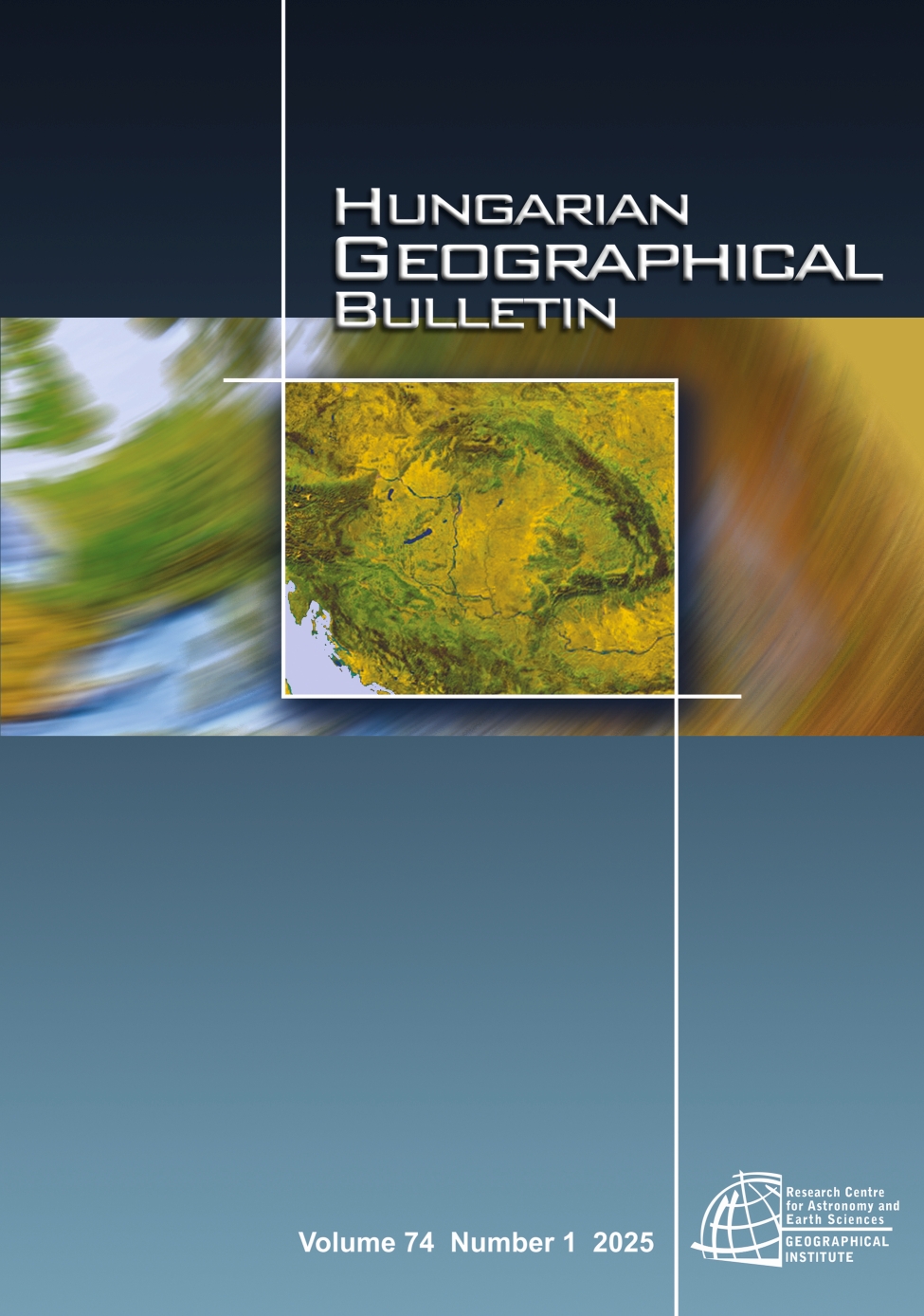Border between West and East of Europe in the mental maps of European university students
Absztrakt
The paper addresses the issue of dividing Europe into two sub-regions, West and East, which are monitored and defined through the method of cognitive mapping. The first section reviews basic approaches to this division of Europe, focusing on the concept of duality, analysing its causes, manifestations and perception in the form of the West-East division. The following empirical part presents the results of an international research conducted in the form of a questionnaire survey distributed among university students from nine European countries. Respondents were asked to define the border between the European West and East based on their subjective perceptions. The results were subsequently analysed and aggregated into map outputs using GIS tools. Although the respondents were young, the findings show that the perceived boundary between West and East still largely aligns with the Cold War-era division of Europe, with Central Eastern European countries, except Slovenia and Czechia, often classified as East. The mental maps also showed partial differences in the views of individual nations. The final part of the study is devoted to the interpretation of the results and their reflection in terms of the presented theoretical concepts and assumptions.
Hivatkozások
ANDĚL, J., BIČÍK, I. and BLÁHA, J.D. 2018a. Macro-regional differentiation of the world: Authors’ concept and its application. Miscellanea Geographica. Regional Studies on Development 22. (3): 117–122. https://doi.org/10.2478/mgrsd-2018-0025
ANDĚL, J., BIČÍK, I. and BLÁHA, J.D. 2018b. Concepts and delimitation of the world’s macro-regions. Miscellanea Geographica. Regional Studies on Development 22. (1): 16–21. https://doi.org/10.2478/mgrsd-2018-0001
ANDĚL, J., BIČÍK, I. and BLÁHA, J.D. 2019. Makroregiony světa. Nová regionální geografie (World’s macro-regions. The new regional geography). Praha, Karolinum.
BARTASEVICIUS, V. 2022. Popular understandings of national identity in Europe: Still a gulf between West and East? Nations and Nationalism 29. (3): 939–957. https://doi.org/10.1111/nana.12917
BLÁHA, J.D. and NOVÁČEK, A. 2016. How Central Europe is perceived and delimited. Mitteilungen der Österreichischen Geographischen Gesellschaft 158. 193–214. https://doi.org/10.1553/moegg158s193
CABADA, L. 2020. Central Europe between the West and East: Independent region, the bridge, buffer zone or ‘eternal’ semi-periphery? Politics in Central Europe 16. (2): 419–432. https://doi.org/10.2478/pce-2020-0018
CAHNMAN, W.J. 1949. Frontiers between East and West in Europe. Geographical Review 39. 605–624. https://doi.org/10.2307/210675
CHIROT, D. (ed.) 1991. The Origins of Backwardness in Eastern Europe. Economic and Politics from the Middle Ages until the Early Twentieth Century. Berkeley–Los Angeles–Oxford, University of California Press. https://doi.org/10.1525/9780520911918
COLE, J. 1996. Geography of the World’s Major Regions. New York, Routledge.
COX, H.E. and HUPCHICK, D.P. 2001. The Palgrave Concise Historical Atlas of Eastern Europe. New York, Palgrave. https://doi.org/10.1007/978-1-137-04817-2
DAVIES, N. 2006. Europe East and West: A Collection of Essays on European History. London, Jonathan Cape.
DAVIES, N. 2014. Europe: A History. London, Vintage Publishing.
DE BLIJ, H.J. and MULLER, P.O. 1988. Geography: Regions and Concepts. New York, Wiley.
DELANTY, G. 2012. The historical regions of Europe: Civilizational backgrounds and multiple routes to modernity. Historická sociologie 4. (1): 9–24. https://doi.org/10.14712/23363525.2014.35
DIDELON-LOISEAU, C., DE RUFFRAY, S. and LAMBERT, N. 2018. Mental maps of global regions: identifying and characterizing “hard” and “soft” regions. Journal of Cultural Geography 35. (2): 1–20. https://doi.org/10.1080/08873631.2018.1426950
DOMAŃSKI, B. 2004. West and East in ‘New Europe’: The pitfalls of paternalism and a claimant attitude. European Urban and Regional Studies 11. (4): 377–381. https://doi.org/10.1177/0969776404046272
DOWNS, R.M. and STEA, D. 1973. Cognitive maps and spatial behavior: Process and products. In Image & Environment: Cognitive Mapping and Spatial Behavior. Eds.: EDER, R.M. and STEA, D., New Brunswick, N.J., AldineTransaction, 8–26.
EDER, K. 2006. Europe’s borders: The narrative construction of the boundaries of Europe. European Journal of Social Theory 9. (2): 255–271. https://doi.org/10.1177/1368431006063345
FELLMANN, J.D., GETIS, A. and GETIS, J. 2008. Human Geography: Landscapes of Human Activities. New York, McGraw-Hill.
GRIGG, D. 1965. The logic of regional systems. Annals of the Association of American Geographers 55. (3): 465–491. https://doi.org/10.1111/j.1467-8306.1965.tb00529.x
HAJNAL, J. 1983. Two kinds of preindustrial household formation system. In Family Forms in Historic Europe. Eds.: WALL, R., ROBIN, J. and LASLETT, P., Cambridge, Cambridge University Press, 65–104. https://doi.org/10.1017/CBO9780511897535.003
HALECKI, O. 2000. Historia Europy – jej granice i podzialy (The limits and divisions of European history). Lublin, Institut Europy Srodkowo-Wschodniej.
HAMPL, M. 2009. Global system: situation, contemporary tendencies and possible perspectives of the power potential distribution. Geografie 114. (1): 1–20. https://doi.org/10.37040/geografie2009114010001
HAMPL, M. and MARADA, M. 2015. Sociogeografická regionalizace Česka (Socio-geographic regionalization of Czechia). Geografie 120. (3): 397–421. https://doi.org/10.37040/geografie2015120030397
HARTSHORNE, R. 1939. The nature of geography: A critical survey of current thought in the light of the past. Annals of the Association of American Geographers 29. (3): 173–412. https://doi.org/10.2307/2561063
HEFFERNAN, M. 1998. The Meaning of Europe: Geography and Geopolitics. London, Arnold.
HUNTINGTON, S. 1996. The Clash of Civilisation and the Remaking of the World Order. New York, Simon & Schuster.
IKENBERRY, G.J. 2024. Three worlds: The West, East and South and the competition to shape global order. International Affairs 100. (1): 121–138. https://doi.org/10.1093/ia/iiad284
JOHNSTON, R. and SIDAWAY, J.D. 2016. Geography and Geographers. Anglo-American Human Geography since 1945. London, Routledge. https://doi.org/10.4324/9780203523056
JORDAN, P. 2001. Regional identities and regionalization in East-Central Europe. Post-Soviet Geography and Economics 42. (4): 235–265. https://doi.org/10.1080/10889388.2001.10641171
JORDAN, P. 2005. Großgliederung Europas nach kulturräumlichen Kriterien (Large-scale structuring of Europe according to cultural space criteria). Europa Regional 13. (4): 162–173. https://nbn-resolving.org/urn:nbn:de:0168-ssoar-48072-8
KŁOCZOWSKI, J. (ed.) 2005. Central Europe between East and West. Lublin, Instytut Europy Środkowowschodniej.
KŘEN, J. 2005. Dvě století střední Evropy (Two centuries of the Central Europe). Praha, Argo.
KUNDERA, M. 1984. The tragedy of Central Europe. The New York Review of Books 31. (7): 33–38. https://is.muni.cz/el/1423/jaro2016/MEB404/um/Kundera_1984.pdf
LEMBERG, H. 2000. Ke vzniku pojmu „východní Evropa“ v 19. století. Od „severní“ k „východní“ Evropě (On the emergence of the term „Eastern Europe“ in the 19th century. From „Northern“ to „Eastern“ Europe). In Porozumění: Češi – Němci – východní Evropa 1848–1949. Ed.: LEMBERG, H., Praha, Nakladatelství Lidové noviny, 249–299.
LEWICKI, A. 2023. East–West inequalities and the ambiguous racialisation of ‘Eastern Europeans’. Journal of Ethnic and Migration Studies 49 (1): 1–19. https://doi.org/10.1080/1369183X.2022.2154910
MATLOVIČ, R., KLAMÁR, R., KOZOŇ, J., IVANOVÁ, M. and MICHALKO, M. 2018. Spatial polarity and spatial polarization in the context of supranational and national scales: Regions of Visegrad countries after their accession to the EU. Bulletin of Geography. Socio-economic Series 41. 59–78. https://doi.org/10.2478/bog-2018-0026
MAXWELL, A. 2011. Introduction: Bridges and bulwarks: A historiographic overview of East–West discourses. In The East–West Discourse: Symbolic Geography and its Consequences. Ed.: WAXWELL, A., Oxford, Peter Lang, 1–32.
MEINHOF, U.H. (ed.) 2002. Living (with) Borders. Identity Discourses on East–West Borders in Europe. Aldershot, Ashgate.
MURPHY, A.B., JORDAN-BYCHKOV, T.G. and JORDAN, B. 2020. The European Culture Area. New York, Rowman & Littlefield Publishers.
NAUMANN, F. 1915. Mitteleuropa (Central Europe). Berlin, Reimer. https://doi.org/10.1515/9783112385241
NEUMANN, I.B. 1999. Uses of the Other: "The East" in European Identity Formation. Minneapolis, University of Minnesota Press.
NIEŚCIORUK, K. 2023. Evaluating individual cartographic skills using mental sketches. Cartography and Geographic Information Science 50. (3): 306–320. https://doi.org/10.1080/15230406.2023.2176929
NOVÁČEK, A. 2012a. Dualita Evropy: historickogeografická analýza (The duality of Europe: historical-geographical analysis). Praha, Česká geografická společnost. https://geography.cz/wp-content/uploads/2018/09/eg9.pdf
NOVÁČEK, A. 2012b. Historical-geographical aspects of duality in Europe. Historická geografie / Historical Geography 38. (1): 185–203. https://www.hiu.cas.cz/user_uploads/vydavatelska_cinnost/periodika/historicka_geografie/hg_38_1_2012_fin.pdf
PAASI, A. 1986. The institutionalization of regions: a theoretical framework for understanding the emergence of regions and the constitution of regional identity. Fennia 164. (1): 105–146. https://doi.org/10.11143/9052
POLONSKÝ, F., NOVOTNÝ, J. and LYSÁK, J. 2010. Cognitive mapping of major world regions among Czech geography students. Journal of Maps 6. (1): 311–318. https://doi.org/10.4113/jom.2010.1083
POUNDS, N.J.G. 1969. Eastern Europe. London, Longman.
RUPNIK, J. 1992. Jiná Evropa (The other Europe). Praha, Prostor.
SAARINEN, T. 1999. The Eurocentric nature of mental maps of the world. Research in Geographic Education 1. (2): 136–178. https://hdl.handle.net/10877/16535
SAID, E.W. 1978. Orientalism. New York, Pantheon Books.
SCHENK, F.B. 2013. Mental Maps: The cognitive mapping of the continent as an object of research of European history. European History Online (EGO). Mainz, Leibniz Institute of European History (IEG). https://www.ieg-ego.eu/schenkf-2013-en
SCHENK, F.B. 2017. Eastern Europe. In European Regions and Boundaries. Eds.: MISCHKOVA, D. and TRENCSÉNYI, B., New York–Oxford, Berghahn, 188–209. https://doi.org/10.2307/j.ctvw04gdx.13
SEMIAN, M. and CHROMÝ, P. 2014. Regional identity: Driver or barrier in regional development. Norsk Geografisk Tidsskrift / Norwegian Journal of Geography 68. (5): 263–270. https://doi.org/10.1080/00291951.2014.961540
SIWEK, T. 2011. Percepce geografického prostoru (Perception of geographical space). Praha, Česká geografická společnost.
SOLARZ, M.W. (ed.) 2022. Atlas of Poland’s Political Geography. Poland in the Modern World: 2022 Perspective. Warsaw, Drukarnia Legra. https://atlas2022.uw.edu.pl/materialy-edukacyjne/ebook-do-pobrania/
STEHLÍK, J. 1996. Zařazení České republiky v evropském prostoru (Localization of the Czech Republic in the European Space). Mezinárodní vztahy 2. 95–106. https://doi.org/10.32422/cjir.1453
SZŰCS, J. 1988. The three historical regions of Europe. In Civil Society and the State. Ed.: KEANE, J., London, Verso, 291–332.
TODOROVA, M. 2009. Imagining the Balkans. New York, Oxford University Press. https://doi.org/10.1093/oso/9780195387865.001.0001
The World Factbook 2024. Published by the Central Intelligence Agency (CIA), USA.
UNSTAT 2024. New York, UN United Nations Statistics Division. Available at https://unstats.un.org/unsd/methodology/m49/
WALLERSTEIN, I. 1974. The Modern World-System. Vol. I: Capital Agriculture and the Origins of European World-Economy in the Sixteenth Century. New York–London, Academic Press.
Copyright (c) 2025 Aleš Nováček, Jan D. Bláha, Aneta Zajíčková

This work is licensed under a Creative Commons Attribution-NonCommercial-NoDerivatives 4.0 International License.






